几何体
边缘几何体
可以作为一个辅助对象来查看几何体的边缘。
js
gltfLoader.load("./models/building.gltf", (gltf) => {
console.log(gltf);
//隐藏后就可以直接看到线框
// scene.add(gltf.scene);
//这个模型是由多个几何体组成的,所以需要遍历
gltf.scene.traverse((child) => {
if (child.isMesh) {
//获取几何体
const geometry = child.geometry;
// //获取边缘
const edges = new THREE.EdgesGeometry(geometry);
//创建线条材质
const lineMaterial = new THREE.LineBasicMaterial({ color: 0xff0000 });
//创建线条
const line = new THREE.LineSegments(edges, lineMaterial);
//将线条添加到场景中
scene.add(line);
}
});
});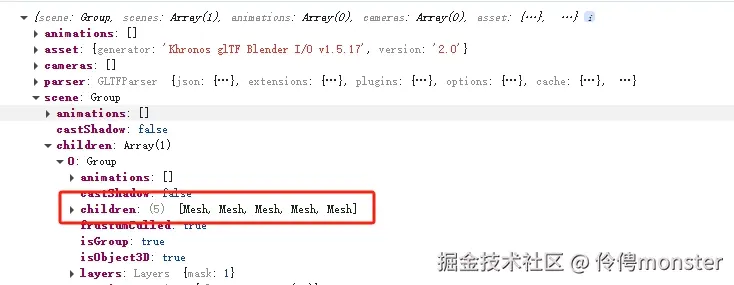
EdgesGeometry 构造函数用于创建边缘几何体,接受一个几何体对象作为参数。
LineBasicMaterial 构造函数用于创建线条材质,接受一个对象作为参数。
LineSegments 构造函数用于创建线条,接受两个参数:
-
geometry: 线条几何体。
-
material: 线条材质。
traverse 方法用于遍历场景中的所有对象,接受一个回调函数作为参数。
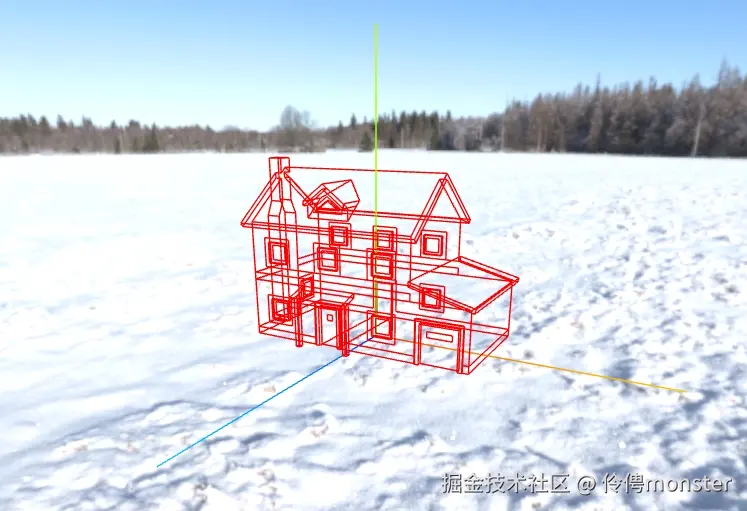
线框几何体
js
let edges = new THREE.WireframeGeometry(geometry);WireframeGeometry 构造函数用于创建线框几何体,接受一个几何体对象作为参数。
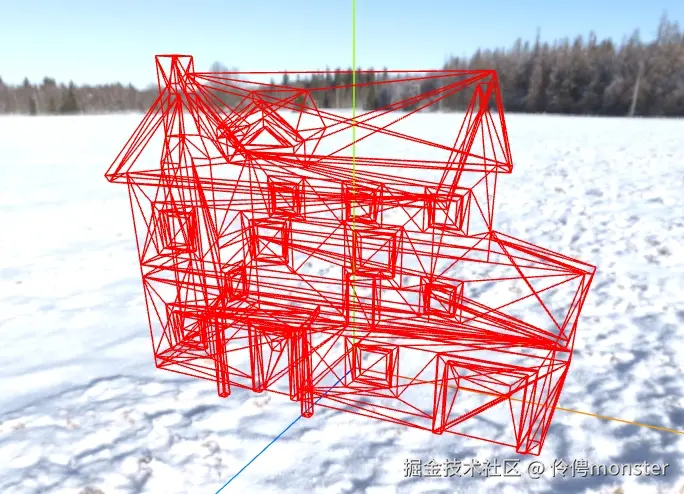
模型解压
在 Three.js 中,模型解压是指将压缩的模型文件解压缩为 Three.js 可以直接使用的模型对象的过程。通常,模型文件在压缩后可以减小文件大小,加快加载速度,但是解压缩过程需要消耗一定的计算资源。
正如上面加载的 building.gltf 模型是压缩过的,如果正常加载会报错,所以需要解压。

DRACOLoader
DRACOLoader 是 Three.js 提供的一个用于加载和解压缩 Draco 压缩格式的模型文件的加载器。Draco 是一个开源的 3D 图形压缩库,可以有效地减少 3D 模型的文件大小,加快加载速度,并保持较高的图形质量。
使用步骤:
- 引入 DRACOLoader
js
import { DRACOLoader } from "three/examples/jsm/loaders/DRACOLoader.js";- 创建 DRACOLoader 实例
js
const dracoLoader = new DRACOLoader();- 设置 DRACOLoader 的解析器路径
js
dracoLoader.setDecoderPath("./draco/");注意: 解析器路径是相对于当前 HTML 文件的路径,所以需要把 three/examples/jsm/libs/draco 文件夹拷贝到项目public中。
- 设置加载器 draco 解码器
js
gltfLoader.setDRACOLoader(dracoLoader);包围盒
包围盒(Bounding Box)是一个用于描述物体体积的几何体,用于计算物体的位置、大小和碰撞等属性。在三维图形学中,包围盒通常用于加速物体的碰撞检测和渲染。
Box3
js
objLoader.load("./models/1.obj", (obj) => {
scene.add(obj);
obj.children[0].material.map = new THREE.TextureLoader().load("./models/nezha.png");
//获取模型,可以直接根据数据找,也可以使用getObjectByName方法
// const nezha = obj.children[0]
const nezha = obj.getObjectByName("texture_v100");
//获取几何体
const nazhaGeometry = nezha.geometry;
//计算包围盒
nazhaGeometry.computeBoundingBox();
//获取包围盒
const nazhaBox = nazhaGeometry.boundingBox;
//创建包围盒辅助线
const nazhaBoxHelper = new THREE.Box3Helper(nazhaBox, 0xff0000);
scene.add(nazhaBoxHelper);
});getObjectByName 方法用于获取指定名称的对象,返回值为对象本身。
.computeBoundingBox() 方法用于计算几何体的包围盒,返回值为包围盒对象。
.boundingBox 属性用于获取几何体的包围盒,返回值为包围盒对象。
Box3Helper 构造函数用于创建包围盒辅助线,接受两个参数:
-
box: 要显示的包围盒对象。
-
color: 辅助线的颜色。
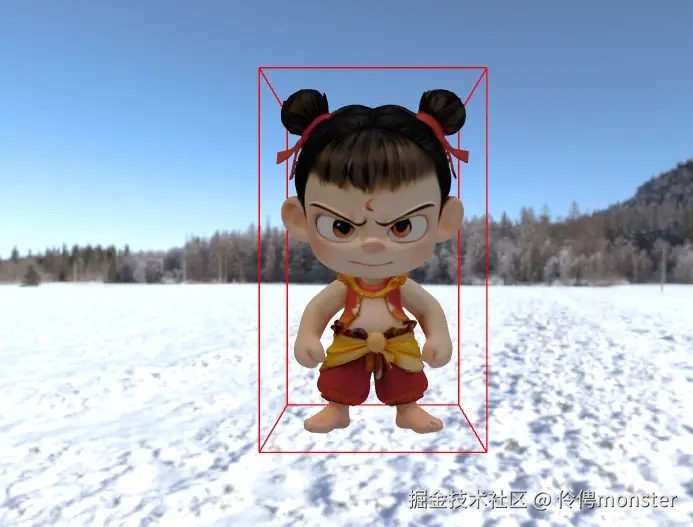

因为生成的包围盒是一个立方体,所以可以直接通过 min 和 max 属性获取立方体的最小和最大坐标。可快速生成包围盒。
Sphere
js
objLoader.load("./models/1.obj", (obj) => {
scene.add(obj);
obj.children[0].material.map = new THREE.TextureLoader().load("./models/nezha.png");
const nezha = obj.getObjectByName("texture_v100");
//获取几何体
const nazhaGeometry = nezha.geometry;
//计算包围球
nazhaGeometry.computeBoundingSphere();
//获取包围球
const nazhaSphere = nazhaGeometry.boundingSphere;
//创建包围球
const sphereGeometry = new THREE.SphereGeometry(nazhaSphere.radius, 16, 16);
const sphereMaterial = new THREE.MeshBasicMaterial({ color: 0x00ff00, wireframe: true });
const sphere = new THREE.Mesh(sphereGeometry, sphereMaterial);
sphere.position.copy(nazhaSphere.center);
scene.add(sphere);
});.computeBoundingSphere() 方法用于计算几何体的包围球,返回值为包围球对象。
.boundingSphere 属性用于获取几何体的包围球,返回值为包围球对象。

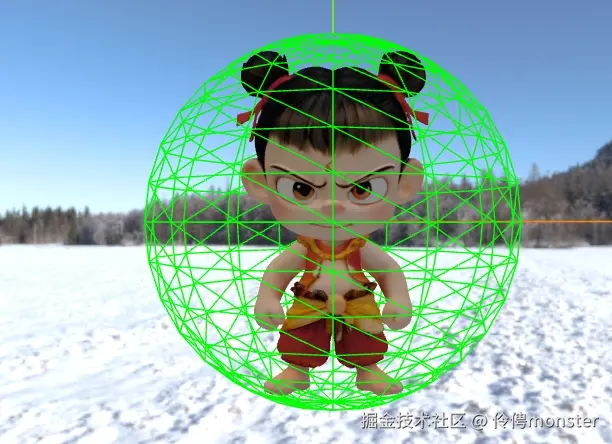
多物体包围
js
//创建球
const sphere1 = new THREE.Mesh(
new THREE.SphereGeometry(0.5, 32, 32),
new THREE.MeshBasicMaterial({ color: 0xff0000 })
);
sphere1.position.set(2, 0, 0);
scene.add(sphere1);
const sphere2 = new THREE.Mesh(
new THREE.SphereGeometry(0.5, 32, 32),
new THREE.MeshBasicMaterial({ color: 0x00ff00 })
);
scene.add(sphere2);
const sphere3 = new THREE.Mesh(
new THREE.SphereGeometry(0.5, 32, 32),
new THREE.MeshBasicMaterial({ color: 0x0000ff })
);
sphere3.position.set(-2, 0, 0);
scene.add(sphere3);
let box = new THREE.Box3();
let sphereArr = [sphere1, sphere2, sphere3];
for (let i = 0; i < sphereArr.length; i++) {
//计算包围盒
sphereArr[i].geometry.computeBoundingBox();
let box3 = sphereArr[i].geometry.boundingBox;
//更新世界矩阵
sphereArr[i].updateMatrixWorld(true, true);
//应用矩阵
box3.applyMatrix4(sphereArr[i].matrixWorld);
//获取包围盒
box.union(box3);
}
const boxHelper = new THREE.Box3Helper(box, 0xff0000);
scene.add(boxHelper);.union() 方法用于合并两个包围盒,返回值为合并后的包围盒对象。
注意: 这里涉及到物体的合并,那么需要先更新世界矩阵,再应用矩阵。
js
//简易方法
for (let i = 0; i < sphereArr.length; i++) {
//第一种
sphereArr[i].geometry.computeBoundingBox();
let box3 = sphereArr[i].geometry.boundingBox;
sphereArr[i].updateMatrixWorld(true, true);
box3.applyMatrix4(sphereArr[i].matrixWorld);
//第二种简易方法
let box3 = new THREE.Box3().setFromObject(sphereArr[i]);
box.union(box3);
}.setFromObject() 方法用于从物体中获取包围盒,返回值为包围盒对象。
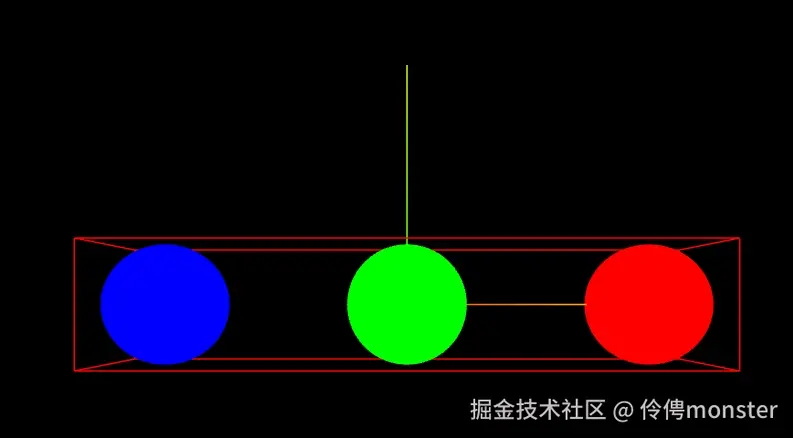
扩展
.getCenter() 方法用于获取包围盒或包围球的中心点,返回值为向量对象。
Geometry.center() 几何体居中,返回值为几何体对象。
.updateWorldMatrix() 方法用于更新几何体的世界矩阵,返回值为几何体对象。
.applyMatrix4(matrix) 方法用于将指定的矩阵应用于几何体的顶点,返回值为几何体对象。
如果存在物体和包围盒的变换,那么需要先更新世界矩阵,再应用矩阵。
js
//更新世界矩阵
nazhaGeometry.updateWorldMatrix(true, true);
//应用矩阵
nazhaGeometry.applyMatrix4(nazha.matrixWorld);书洞笔记\]([mp.weixin.qq.com/s/8cyl1tzrx...](https://link.juejin.cn?target=https%3A%2F%2Fmp.weixin.qq.com%2Fs%2F8cyl1tzrxga4J0LCT56GpA "https://mp.weixin.qq.com/s/8cyl1tzrxga4J0LCT56GpA")